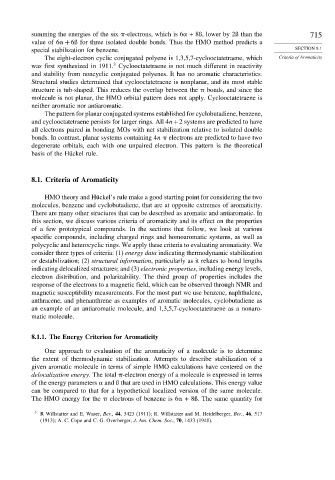Page 732 - Advanced Organic Chemistry Part A - Structure and Mechanisms, 5th ed (2007) - Carey _ Sundberg
P. 732
summing the energies of the six -electrons, which is 6 + 8ß, lower by 2ß than the 715
value of 6 + 6ß for three isolated double bonds. Thus the HMO method predicts a
special stabilization for benzene. SECTION 8.1
The eight-electron cyclic conjugated polyene is 1,3,5,7-cyclooctatetraene, which Criteria of Aromaticity
3
was first synthesized in 1911. Cyclooctatetraene is not much different in reactivity
and stability from noncyclic conjugated polyenes. It has no aromatic characteristics.
Structural studies determined that cyclooctatetraene is nonplanar, and its most stable
structure is tub-shaped. This reduces the overlap between the bonds, and since the
molecule is not planar, the HMO orbital pattern does not apply. Cyclooctatetraene is
neither aromatic nor antiaromatic.
The pattern for planar conjugated systems established for cyclobutadiene, benzene,
and cyclooctatetraene persists for larger rings. All 4n+2 systems are predicted to have
all electrons paired in bonding MOs with net stabilization relative to isolated double
bonds. In contrast, planar systems containing 4n electrons are predicted to have two
degenerate orbitals, each with one unpaired electron. This pattern is the theoretical
basis of the Hückel rule.
8.1. Criteria of Aromaticity
HMO theory and Hückel’s rule make a good starting point for considering the two
molecules, benzene and cyclobutadiene, that are at opposite extremes of aromaticity.
There are many other structures that can be described as aromatic and antiaromatic. In
this section, we discuss various criteria of aromaticity and its effect on the properties
of a few prototypical compounds. In the sections that follow, we look at various
specific compounds, including charged rings and homoaromatic systems, as well as
polycyclic and heterocyclic rings. We apply these criteria to evaluating aromaticity. We
consider three types of criteria: (1) energy data indicating thermodynamic stabilization
or destabilization; (2) structural information, particularly as it relates to bond lengths
indicating delocalized structures; and (3) electronic properties, including energy levels,
electron distribution, and polarizability. The third group of properties includes the
response of the electrons to a magnetic field, which can be observed through NMR and
magnetic susceptibility measurements. For the most part we use benzene, naphthalene,
anthracene, and phenanthrene as examples of aromatic molecules, cyclobutadiene as
an example of an antiaromatic molecule, and 1,3,5,7-cyclooctatetraene as a nonaro-
matic molecule.
8.1.1. The Energy Criterion for Aromaticity
One approach to evaluation of the aromaticity of a molecule is to determine
the extent of thermodynamic stabilization. Attempts to describe stabilization of a
given aromatic molecule in terms of simple HMO calculations have centered on the
delocalization energy. The total -electron energy of a molecule is expressed in terms
of the energy parameters and ß that are used in HMO calculations. This energy value
can be compared to that for a hypothetical localized version of the same molecule.
The HMO energy for the electrons of benzene is 6 + 8ß. The same quantity for
3
R Willstatter and E. Waser, Ber., 44, 3423 (1911); R. Willstatter and M. Heidelberger, Ber., 46, 517
(1913); A. C. Cope and C. G. Overberger, J. Am. Chem. Soc., 70, 1433 (1948).

